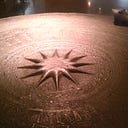Sunda on the Atlas Miller (1519)
This post is an addendum to my earlier piece on Duarte Barbosa’s description of Sunda/West Java, which you can find here.
In his 1516 book on the geography of Asia, the Portuguese conquistadore Duarte Barbosa described Sunda as an island in the sea between Sumatra and Java. Sunda is in fact the western third of the island of Java and most of it now goes under the name of ‘West Java’ (Indonesian: Jawa Barat — Figure 1). This irks some Sundanese people (it’s a bit like calling Wales ‘West England’) but it is at least unlikely that anybody would presume ‘West Java’ to be an island, as Barbosa appears to have done with Sunda in the early sixteenth century.
Another Portuguese source from the same period, the Atlas Miller (aka Miller Atlas or Lopo Homem-Reineis Atlas — Paris, BnF, GE DD-683), also depicts Sunda as an island, suggesting this was the standard view among the Portuguese at the time. The Atlas was drawn in 1519 by Lopo Homem, Pedro Reinel, and collaborators, and shows the entire world then known to the Portuguese, including notably <MVNDVS NOVVS> ‘the New World’, with a reasonably accurate depiction of the coast of Brazil. (1) The captions are in Latin in a beautiful hand, and whimsical illustrations have been liberally strewn about the pages, among them parrots and ships and the supposedly floating tomb of Muhammad (pbuh), incorrectly placed at <MECHA>. (2)
Figure 2 below is taken from feuille 3 of the digitised version of the Atlas, an almost completely inaccurate depiction of the Indo-Malaysian archipelago. The map here shows few signs of having moved on from the cartography of the fifteenth century. One of the islands here is based on a medieval copying error — <CANDIN INSVLA>, there on the right, which seems to derive from the island of Dondin in the Itinerario of Odoric of Pordenone (c.1330) — and you’ll note that there are two Javas depicted here, one big and one small. Sumatra is named <TAPROBANA INSVLA> on this page (and <TRAPORBANA> on the preceding one), reflecting Greco-Roman geography as seen through a fifteenth-century Italian humanist prism. (3) Even the mess of coloured blobs on the left representing islands has earlier medieval counterparts, as on the 1375 Catalan Atlas (Paris, BnF, Espagnol 30).
Sunda does not appear on many earlier maps, however, and was never part of the medieval European cartographic tradition. It doesn’t feature on medieval Chinese or Middle Eastern maps, either, as far as I know. Its appearance on the Atlas Miller — as a separate island some way to the south of the two Javas — may well be the earliest depiction of the region/kingdom on any map made in Europe, although I could easily be wrong about that. The only earlier depiction I can think of is on the Francisco Rodrigues map, made in Melaka shortly after Abreu’s 1512 expedition to Maluku and Banda in 1512. Here’s Sunda on the Atlas Miller, in any case (Figure 3):
By 1519 Portuguese had already conquered Melaka, the foremost power on the Malay Peninsula between about 1400 and the time of the conquest in 1511 under Afonso de Albuquerque (Figure 4). Albuquerque subsequently dispatched one expedition to Timor, Maluku, and Banda in 1512 (led by Antonio de Abreu, who had been shot in the face by a musket during the battle for Melaka in August 1511) and another to Java in 1513. Through these expeditions the Portuguese acquired knowledge of Sunda. Unfortunately only the bare fact of Sunda’s existence seems to have filtered down to Lopo Homem et al., and it would take a few decades before European cartographers depicted this region with any accuracy.
I think several island confusions in the historical geography of the Indo-Malaysian archipelago can be most parsimoniously explained with reference to terms in the local languages. Nusa means ‘island’ — but in the old texts it seems to mean ‘polity’ or ‘place’ just as often. Chinese, Arabic, and Latin all have fairly clear-cut words for ‘island’. It’s easy to imagine how mix-ups could come about when speakers of these languages went to island Southeast Asia; an informant talking about nusa Sunda could easily have been taken to have been describing an island.
NOTES
(1) This ‘New World’ is covered, as per the 1494 Treaty of Tordesillas, in Spanish coats-of-arms.
(2) The tomb of Muhammad (pbuh) is in fact in Medina. A medieval Christian meme asserted that his tomb was in Mecca, suspended above the ground as if floating.
(3) Compare Poggio Bracciolini’s De Uarietate Fortunæ (1448), in which the connection between the ancient Taprobana and Sumatra seems to have first been proposed. Taprobana almost certainly originally referred to Sri Lanka in the Greek and Latin texts.
I have a Ko-Fi account, in case you’re interested in showing your appreciation for this and other Medium stories: https://ko-fi.com/P5P6HTBI
